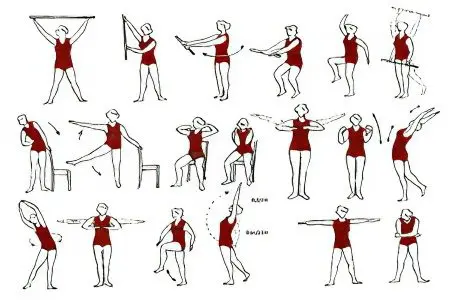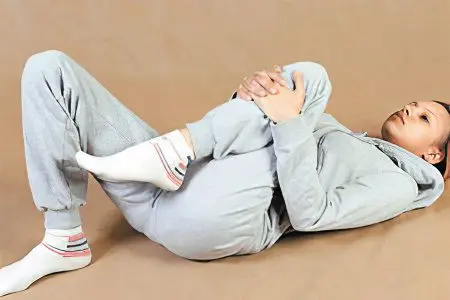Contents
Exercises for periarthritis is a gymnastic complex that is aimed at eliminating the unpleasant symptoms of the disease and speeding up the healing process. Since all periarticular tissues become inflamed during periarthritis, it is necessary to provide them with regular and uninterrupted access to nutrients and oxygen. This can be achieved through regular exercise. However, it should be borne in mind that exercises for periarthritis can bring not only benefits, but also harm. Therefore, it is necessary to make a complex based on the individual characteristics of the organism, as well as take into account a number of other factors.
What will be the effect of training?

Regular exercise will solve the following problems:
Increase muscle tone.
Strengthen muscles.
Return normal performance to ligaments and tendons.
Improve blood supply to the affected area.
Increase range of motion in the joint.
An important condition for starting regular training is the transition of the disease from the acute stage to the stage of remission, when the main symptoms of periarthritis are eliminated and the inflammation is relieved.
Features of performing exercises with periarthritis

Before starting any gymnastic complex, no matter how safe it may seem, you need to consult with a specialist. It is great if there is an opportunity to start exercising under the guidance of a physiotherapist who has experience in treating such diseases. Only after all the exercises have been worked out with a specialist, you can begin to perform them at home.
Charging is best done after undergoing physiotherapy treatment.
Before proceeding with the implementation of a particular complex, it is necessary to warm up the muscles. This will help to make intensive walking, during which not only the legs, but also the arms should be involved.
The starting position of the body during exercise should constantly change.
During training, it is permissible to use various sports equipment: balls, dumbbells, gymnastic sticks, expanders, etc.
At the initial stage, you need to perform exercises no more than 2-3 times a week. In the future, it will be possible to practice every day.
The increase in load should be gradual.
You can’t skip classes.
You need to perform the exercises smoothly, without making sudden movements.
Exercise should not hurt a person.
You should not already perform exercises to the maximum at the first training session. Progress towards the goal should be comfortable. This is the only way to achieve a lasting effect.
Exercises for shoulder-scapular periarthritis

The eminent doctor P. A. Popov, who for many years practiced precisely in the treatment of periarthritis, developed his own system of exercises, which are based on the performance of “small movements”. The doctor suggests that his patients gradually stretch and rock the diseased joint. Pain and discomfort during the exercise are unacceptable companions.
Popov’s exercises:
Starting position: lying on your back, arms extended along the body. It is necessary to bend them at the elbows by 90 ° C. In this position, you need to squeeze and unclench your fingers into a fist 10 times. Then shake the brushes.
Starting position as in the previous exercise. It is necessary to bend and unbend the hands in the wrist joint at least 4 times.
Starting position: lying on your back, arms extended along the body. Brushes need to alternately turn the palms up and down. Repeat the exercise 8 times.
Lying on your back, put your hands behind your head, spreading your elbows in different directions. Repeat the exercise 4 times.
Lying on your back, pull up alternately the right, then the left hand. During inhalation, the lift is performed, during exhalation, the limb is returned to its place.
Starting position: sitting on a chair with arms lowered along the body. It is necessary to slowly perform circular movements with the shoulder joints, 6 times forward and 6 times back.
Sitting on a chair, you need to alternately take your hands to the side and hold them on weight for at least 5 seconds. The number of repetitions of the exercise is at least 4.
Sitting on a chair, put your palms on your shoulders, lower your elbows down. Alternately touch the elbows of the opposite knee, slightly raising the latter.
Other exercises that are effective in the treatment of humeroscapular periarthritis:
Shoulders need to draw the number 8 in the air. First, it is performed by the exercise with two shoulders together, and then with each shoulder alternately.
Raise your shoulders high, which will stretch the spinal column.
Performing the exercise “scissors”.
Raise your straight arm up in turn, turning the body in the direction of the outstretched arm.
Join hands in the castle, holding them in front of the chest. Make a wave, slowly increasing the pace.
Bend your arm at the elbow and raise it up, repeating the movement of the bird’s wing during the flight.
Sitting on a chair, you need to try to reach your knees with your shoulders.
Sitting on the floor with straight legs apart, you need to stretch your straight arms to the toes.
Exercises from a standing position, with legs spaced shoulder-width apart:
Rotations with the hands that are brought out in front of you. Number of turns: 10 in one direction and 10 in the opposite direction.
Swing your arms to the right and left: one arm remains motionless, laid aside. With the second hand, you need to touch her palm, while turning the body.
It is necessary to join hands in the lock behind the back, trying to reach the fingers of one hand to the fingers of the other hand. If the exercise fails the first time, do not despair. Gradually, the lost range of motion will return and the “lock” can be closed.
Perform hand swings according to the type of actions that a person performs while running. In this case, the legs should remain motionless.
The gymnastic complex should be completed by performing circular rotations of the head. Hands at this time should be lowered down.
After the exercises are completed, it is recommended to lie on a hard, flat surface, on your back. In this position, you should spend half an hour, allowing the muscles to relax and rest.
Exercises for knee periarthritis

Although humeroscapular periarthritis is more common than other forms of the disease, however, some people suffer from knee periarthritis.
There are therapeutic and gymnastic complexes aimed at working out the muscles in this particular part of the body:
It is necessary to sit on a chair with a flat back, lower your arms along the torso. From this position, bend and unbend the legs at the knees, holding them on weight for 3-5 seconds. Number of repetitions: 5-7 times.
You need to sit on the floor, bending your leg at the knee joint and pull it towards you. The second leg should be straight. You should stay in this position for 3 seconds, then return to the starting position and repeat the exercise for the second leg. Number of approaches: 5 times for each leg.
It is necessary to lie on your stomach, rise on your elbows, legs remain pressed to the floor. Then alternately, smoothly and slowly, you should bend your knees, raising your lower leg to parallel with the ceiling.
Lying on your back, you need to rise on your elbows, placing your hands behind your back. It is necessary to alternately pull the legs towards you, bending them at the knee joint. You should try to touch your chest with your foot.
Take a small box that will act as a home “step platform”. Alternately step on the elevation, simulating the ascent of the stairs. The pace should not be too intense, the movements should be performed slowly and smoothly. You need to start with 10-15 steps for each leg, gradually increasing the load.
Spread your legs shoulder-width apart, stretch your arms in front of you, do squats, but not deep. To begin with, you should do 2 sets of 5 squats, the depth of the squat should also be increased gradually.
You need to sit on a chair, raise your legs above the floor and imitate cycling, as if scrolling the pedals with your feet.
By stimulating blood circulation, these exercises will help get rid of muscle pain, as well as increase the range of motion in the joint. If the body responds with pain to every movement of the knee, then the complex should be abandoned after consulting a doctor.
Exercises for ankle and foot periarthritis
This selection of exercises will allow you to quickly cope with inflammation in the muscles surrounding the joints of the foot and lower leg:
Sitting on a chair, you need to bend your leg at the knee, take the ankle joint in your hand and gently rotate it. Perform 5 rotations in one direction and 5 rotations in the other direction for each leg.
Sitting on a chair, you should raise your legs to parallel with the floor and perform rotational movements with your feet in one direction and the other. You need to complete 7 rotations.
Sitting on a chair, you need to put a fabric on the floor and try to wrinkle it with your toes, and then smooth it out.
Sitting on a chair, you need to turn your feet with toes in different directions, and press your heels to each other. From this position, you must try to raise your legs, stretching them on your toes, and then slowly lower them back.
Sitting on a chair, one should try to roll a water bottle or a stick, using only the feet and fingers for this purpose.
If you perform these exercises every day, you will be able to achieve a stable remission of the disease and prevent its progression. The complex is good in that it can be performed even at the workplace.









